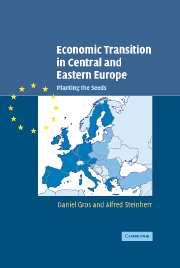Book contents
- Frontmatter
- Contents
- List of figures
- List of boxes
- List of tables
- Acknowledgements
- Introduction
- Part I The rise and decline of communism: an overview
- Part II Transition: 1990–2000
- Part III Extreme cases for reform: scope for disagreements
- 6 German unification: an example of big-bang reform
- 7 The disintegration of the Soviet Union
- 8 Russia: after a lost decade, the phoenix rises from the ashes?
- Part IV The new Europe from the Atlantic to the Urals
- References
- Index
7 - The disintegration of the Soviet Union
Published online by Cambridge University Press: 05 June 2012
- Frontmatter
- Contents
- List of figures
- List of boxes
- List of tables
- Acknowledgements
- Introduction
- Part I The rise and decline of communism: an overview
- Part II Transition: 1990–2000
- Part III Extreme cases for reform: scope for disagreements
- 6 German unification: an example of big-bang reform
- 7 The disintegration of the Soviet Union
- 8 Russia: after a lost decade, the phoenix rises from the ashes?
- Part IV The new Europe from the Atlantic to the Urals
- References
- Index
Summary
Before 1990 nobody would have ventured to suggest that the Soviet Union might disappear. When it did in 1991 most observers saw it as a historical accident. We argued in Gros and Steinherr (1991a), written before the split, that the explosion was unavoidable and, in economic terms at least, desirable.
It is, in fact, interesting to observe that socialist states with a federal structure – the Soviet Union, Yugoslavia and Czechoslovakia – split up during transition. There are strong reasons for this dramatic failure. First, all three federations were composed of different ethnic groups with a history of painful conflicts. Adversity was reinforced in the Soviet Union and Yugoslavia by religious differences. Second, the Soviet Union and Yugoslavia were artificial, imperial creations. As argued in chapter 1, the Soviet Union just pursued Russian imperialism by adding the Baltic states, transferred entire ethnicities and subjugated dissonant people or countries, such as the Ukraine. Togetherness was maintained only by brute force in all three federations. Third, none of the three federations provided a harmonious balance of rights and responsibilities between the centre and the states of the federation. The federal structure was a paper construction, a Potemkin façade. All the power was with a Communist Party that had a monolithic structure. States of the federations had little real autonomy. Fourth, in market-based federations, such as Germany or the United States, income redistribution is achieved through budgetary transfers. Rich states keep most of their revenue, but support less prosperous states.
- Type
- Chapter
- Information
- Economic Transition in Central and Eastern EuropePlanting the Seeds, pp. 187 - 224Publisher: Cambridge University PressPrint publication year: 2004



